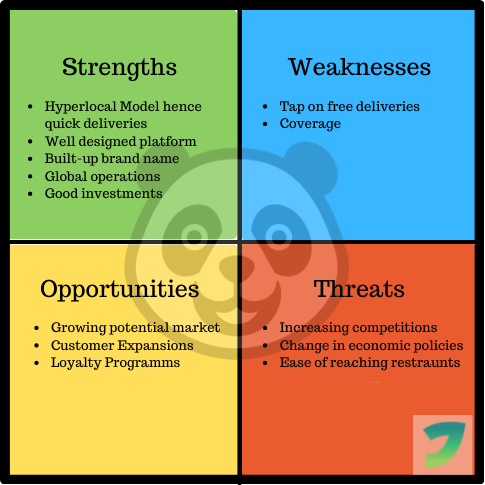
Foodpanda is an online food delivery platform that connects users to thousands of local food points i.e catering to the hyperlocal delivery model. It is one of the most widely used apps for ordering food from restaurants. Users can choose from a variety of menus and place orders for home delivery or pick-up at the most competitive prices. It only takes a few clicks. Foodpanda provides menus, customer ratings, and other information for over 115000+ restaurants in over 12 countries.
Foodpanda began operations in March 2012 in Singapore.
In this article-
- The business model of Foodpanda
- How does an online food ordering platform work?
- Benefits Foodpanda has been reaping through its hyperlocal business model
- The revenue model of Foodpanda
- SWOT analysis of Foodpanda
- The cost channels of Foodpanda
- The best solution to build an online food ordering app/website
The business model of Foodpanda
Foodpanda maintains a website and a mobile app that allows its customers to order food from listed restaurants.
How does an online food ordering platform work?
There are 4 types of stakeholders involved in the working process of an online food ordering marketplace: Marketplace Owner/Admin, Merchant, Customer, and Delivery Management. Here is the breakdown of how things work in an online food ordering marketplace:
The administrator forms partnerships with merchants from various regions and adds a number of restaurants to the platform.
Merchants include information such as the restaurant’s name, menu items, operating hours, working days, and packaging information, among other things.
Customers can sign up for the platform using their email address or a social media account.
Customers use an advanced search tool provided on the platform to find their favorite restaurants and select food items after completing the registration process.
Customers confirm their orders by paying via their preferred payment method.
Merchants take the order and begin preparing the food according to the suggestions of the customers.
After receiving order requests, delivery boys go to the merchant’s location to pick up the order.
Customers may follow the status of their orders as well as the position of the delivery team in real-time.
When the food is ready, the delivery team picks it up and delivers it to the consumers. The platform/app owner or the merchant is in charge of the order delivery.
Every order placed through the platform earns the marketplace owner a portion of the commission, with the remainder going to the merchant’s account.
Benefits Foodpanda has been reaping through its hyperlocal business model
1. Increasing demand for hyperlocal online food delivery services
Due to the Coronavirus epidemic, SMBs and conglomerates in the online food delivery sector have seen a large increase in demand for their food delivery services over the previous year. During the second and third quarters of 2020, revenue for Foodpanda, DoorDash, Grubhub, Uber Eats, and Postmates increased by 3 billion dollars.
According to a recent estimate by Statista, the total number of users in the food delivery market is predicted to reach 1589.3 million by 2024. According to Business Wire, the worldwide internet food delivery business is expected to reach $192.16 billion by 2025.
Factors like the increasing demand and future predictions make it a very sound case for entrepreneurs to start an online food ordering marketplace for their business growth.
2. User engagement
Restaurant owners might consider launching an online food ordering platform in order to attract a larger audience and increase revenue. It would be simple to serve people in remote areas with online food delivery services. Customers could be notified of discounts and holiday deals offered on food goods via push notifications sent by an online food delivery company.
3. Improved logistics control
Starting an online food ordering platform can help restaurateurs manage their logistics operations more efficiently. They can keep track of their delivery personnel’s whereabouts in real-time and monitor their progress in real-time. Restaurant operators may handle several orders from a specific area and dispatch the appropriate number of vehicles to delivery locations. Restaurant proprietors may benefit from an online food delivery platform that includes capabilities like BOPIS, geofencing, location tracking, and more.
4. Supporting local restaurants
The COVID-19 pandemic has wreaked havoc on the restaurant business. Local restaurants have struggled to thrive in the food business as a result of the severe limitations implemented by various governments on a timely basis during the last year. In these difficult times, entrepreneurs must invest in the online food ordering industry to assist small and mid-sized restaurant operators. Restaurants can advertise their establishments on the marketplace to sell food online and increase brand awareness.
Seeking to set up the hyperlocal business, exactly like Foodpanda? Check here.
The revenue model of Foodpanda
Registration fee for restaurants
To list a restaurant on Foodpanda’s website/app, the establishment must pay a registration fee. Customers looking for local eateries will be able to see the eatery once it has been added by Foodpanda. The cost of registration varies between $100 and $150. It’s a one-time payment.
From the restaurant Commission
Restaurants pay Foodpanda a commission on every food order they get through their platform. In most cases, the commission is between 15% and 25%, including all taxes. The commission is determined by the restaurant’s location, its reliance on Foodpanda, and the volume and kind of orders it receives.
Customers Pay a Delivery Fee
Each order a consumer puts on the Foodpanda app is subject to a delivery cost. Customers must also pay various taxes in addition to this price.
Advertisement
Many eateries, particularly newcomers, use Foodpanda as a marketing platform. By enrolling with Foodpanda, restaurants may boost their visibility. They can also pay a fee to have their brand advertised on the app.
Affiliate Earnings
Foodpanda also makes money by making recommendations on various banks’ credit cards. Furthermore, to stimulate transactions, banks give out discounts and special offers on their cards. For affiliate marketing, Foodpanda works with these banks.
SWOT analysis of Foodpanda

Strengths
- Hyperlocal Model hence quick deliveries
- Well designed platform
- Built-up brand name
- Global operations
- Good investments
Weaknesses
- Tap on free deliveries
- Coverage
Opportunities
- Growing potential market
- Customer Expansions
- Loyalty Programms
Threats
- Increasing competitions
- Change in economic policies
- Ease of reaching restraunts
The cost channels of Foodpanda
- Development and maintenance cost of its online ordering system. The system comprises Foodpanda’s website, merchant app, customer app, delivery partner app, and the backend setup for managing everything.
- Salaries and provisions for full-time employees.
- Salaries and incentives for distribution partners.
- Administrative costs.
- Customers are given benefits in the form of offers.
- Returns and refunds.
- Miscellaneous expenses.
The best solution to build an online food ordering app/website
Online food ordering platforms like Foodpanda, Swiggy, Grubhub, UberEats compete for a long time. To compete with them, choose the right food ordering platform and the best app development company.
Enthusiastic entrepreneurs must capitalize on the current dynamics to give customers what they want; and also commence a thriving startup in the process. To accelerate the growth of this potential sector, Yelo by Jungleworks offers a no-code cloud-based on-demand ordering platform where hyperlocal businesses can offer direct-to-consumer and multi-vendor services to consumers.
Yelo helps you to build a highly efficient and technologically sound hyperlocal ordering platform without the need for coding. You don’t have to create your whole store from scratch, as Yelo offers pre-built modules for all the essential features you need for your business.
It offers inbuilt themes and other pre-created aesthetic elements to help you craft your own brand image. With access to several advanced features such as 100+ payment gateways, 500 integrations, availability in 50+ languages, and many more, you can make your brand highly personalized, thus enhancing their shopping experience.
Start with Yelo’s 14 days free trial now!
To read more about successful business models, follow our resource section.
Subscribe to stay ahead with the latest updates and entrepreneurial insights!

Subscribe to our newsletter
Get access to the latest industry & product insights.























